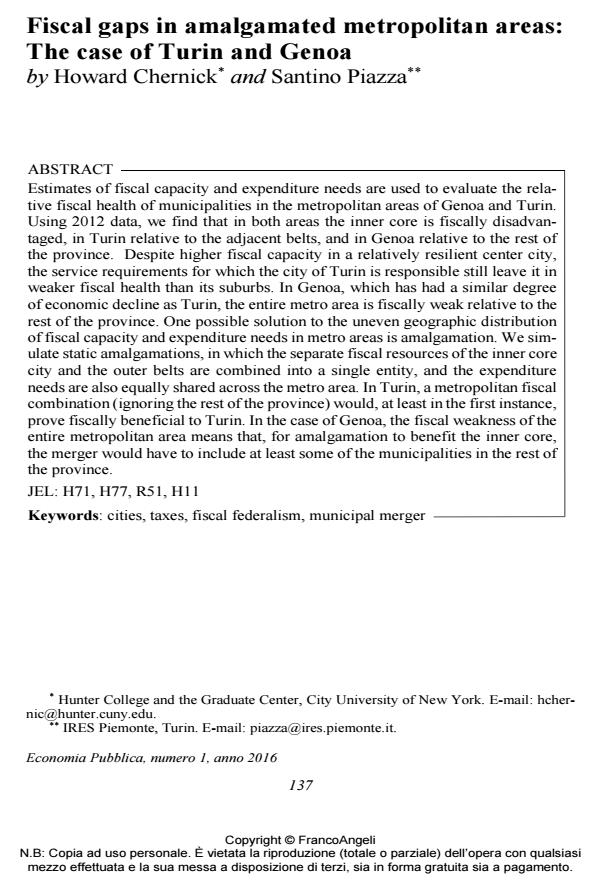Fiscal gaps in amalgamated metropolitan areas: The case of Turin and Genoa
Journal title ECONOMIA PUBBLICA
Author/s Howard Chernick, Santino Piazza
Publishing Year 2016 Issue 2016/1
Language English Pages 35 P. 137-171 File size 459 KB
DOI 10.3280/EP2016-001007
DOI is like a bar code for intellectual property: to have more infomation
click here
Below, you can see the article first page
If you want to buy this article in PDF format, you can do it, following the instructions to buy download credits

FrancoAngeli is member of Publishers International Linking Association, Inc (PILA), a not-for-profit association which run the CrossRef service enabling links to and from online scholarly content.
Estimates of fiscal capacity and expenditure needs are used to evaluate the relative fiscal health of municipalities in the metropolitan areas of Genoa and Turin. Using 2012 data, we find that in both areas the inner core is fiscally disadvantaged, in Turin relative to the adjacent belts, and in Genoa relative to the rest of the province. Despite higher fiscal capacity in a relatively resilient center city, the service requirements for which the city of Turin is responsible still leave it in weaker fiscal health than its suburbs. In Genoa, which has had a similar degree of economic decline as Turin, the entire metro area is fiscally weak relative to the rest of the province. One possible solution to the uneven geographic distribution of fiscal capacity and expenditure needs in metro areas is amalgamation. We simulate static amalgamations, in which the separate fiscal resources of the inner core city and the outer belts are combined into a single entity, and the expenditure needs are also equally shared across the metro area. In Turin, a metropolitan fiscal combination (ignoring the rest of the province) would, at least in the first instance, prove fiscally beneficial to Turin. In the case of Genoa, the fiscal weakness of the entire metropolitan area means that, for amalgamation to benefit the inner core, the merger would have to include at least some of the municipalities in the rest of the province.
Keywords: Cities, taxes, fiscal federalism, municipal merger
Jel codes: H71, H77, R51, H11
Howard Chernick, Santino Piazza, Fiscal gaps in amalgamated metropolitan areas: The case of Turin and Genoa in "ECONOMIA PUBBLICA " 1/2016, pp 137-171, DOI: 10.3280/EP2016-001007